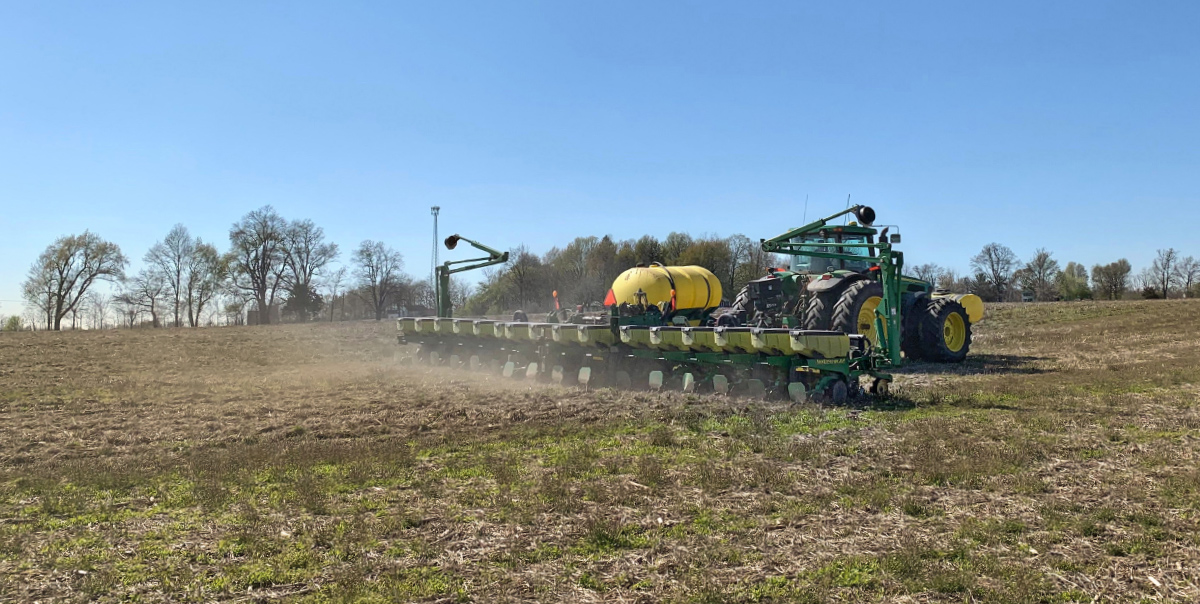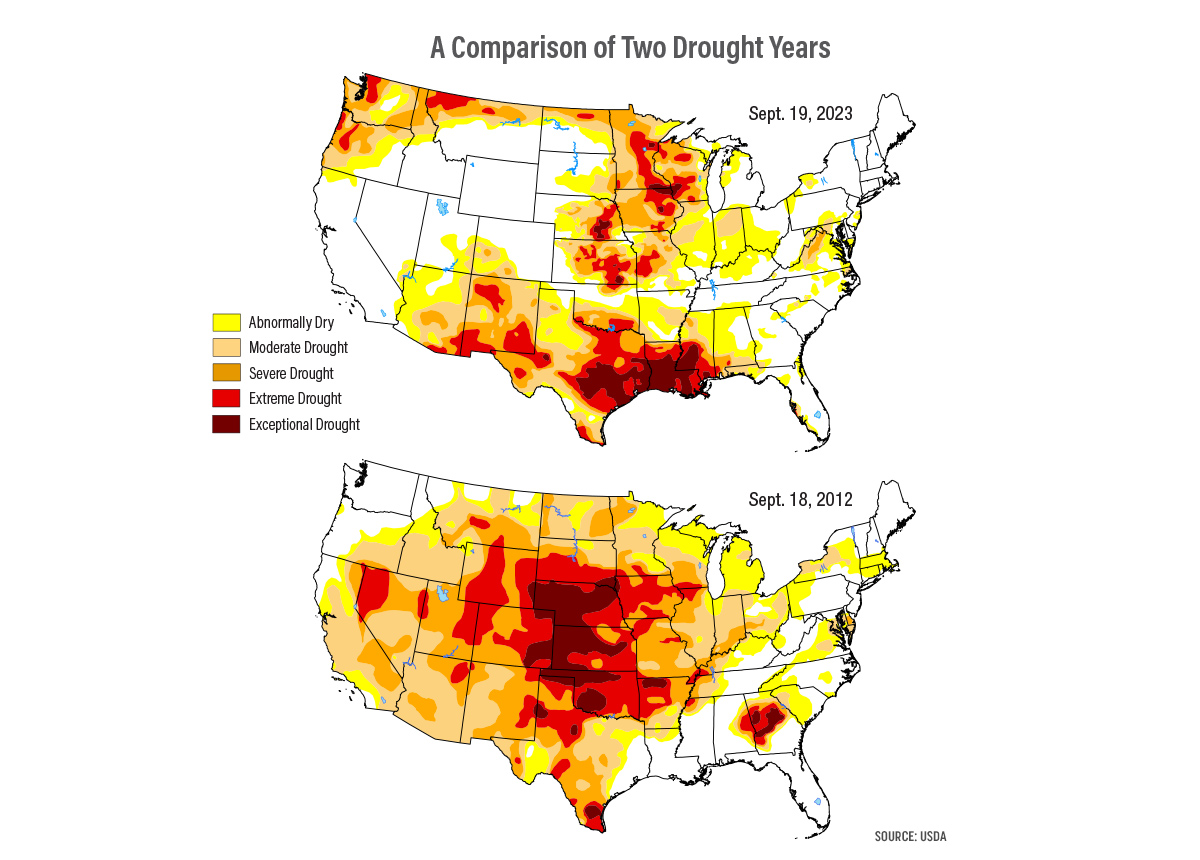Seed Technology and Evolving Farming Practices Win Against Drought's Grip

Farm Journal’s Smart Farming Week is an annual week-long emphasis on innovation in agriculture. The goal is to encourage you to explore and prioritize the technology, tools and practices that will help you farm smarter. Innovation today ensures an efficient, productive and sustainable tomorrow.
It’s been said a high-yielding corn crop needs 25" of moisture per acre per year. Of course, the timing of that rain makes all the difference, but management strategies to retain soil moisture coupled with genetic technology have been a boon for bushels in recent years when Mother Nature didn’t cooperate.
Minnesota Farm Scores big with Only 7" of Rain
In 2023, David Heublein grew a contest-winning corn yield of 314.93 bu. with only 7" of rain in Minnesota. If you wonder how that’s possible, you’re in good company. Heublein says he is still amazed by the experience.
“We thank the good Lord for providing just enough rain to give us this yield,” says Heublein, who won the conventional, non-irrigated category of the National Corn Growers Association (NCGA) yield contest for Minnesota. He farms in the southeast corner of the state with his wife, Jennifer.
Trait Tech Pays Off
The winning entry of DKC59-82RIB was planted in a 40-acre field at the couple’s home farm near Lewiston, in Winona County, on May 1 and was harvested Oct. 11. On the day before harvest, the U.S. Drought Monitor showed 75% of Minnesota’s corn crop, including Heublein’s, was enduring moderate (D1) to extreme (D2) drought.

“I’m convinced these high-yielding hybrids with new traits are a huge reason for our success,” Heublein says. “I’m also blessed to be surrounded with knowledgeable, caring individuals who help me make qualified decisions to better my bottom line.”
Heublein also credits his success to careful planting and harvesting practices, timely fertilizer and fungicide applications, the area’s nutrient-rich Port Byron and Mt. Carroll soils, moderate temperatures that climbed above 90°F only two times during the summer and the precious inches of timely rainfall.
“We recorded 1.1" in May, 1.5" in June, 3.9" in July and just a half inch in August for a grand total of 7" for the season,” Heublein recalls. “That was about one-third of our normal rainfall. What these hybrids can go through with the weather we have today and still put on a good-sized ear with such kernel depth amazes me.”
Two other farms Heublein grows corn on didn’t fare well last season. The family’s farm north of Fremont, Minn., received only 5" of total rainfall. Their farm, near Wilson, Minn., was hit with high wind and golf ball-sized hail on July 14. As a result, corn yields on both farms tanked.
Looking Ahead
Heublein says he anticipates he’ll enter the NCGA yield contest again in 2024. He and Jennifer have competed in the annual contest since 1991.
“I like seeing how our crop compares with other corn yields across the state and the nation,” Heublein says. “Getting over 300 bu. was a real accomplishment and an incredible experience. It’s really fun to see what these hybrids can do.”
Attention to Detail Matters
Every growing season, David Heublein focuses on about 15 practices to produce a high-yielding corn crop. “Attention to detail is so important because there’s no silver bullet,” he says. “Last year, so many things worked to our favor on the Lewiston farm.”
These five practices top the list:
- Garden-like soil conditions with excellent subsoil moisture made it easier for him to achieve a consistent planting depth of 1.75".
- Good technology is a benefit, such as DeltaForce to keep 100 lb. of down pressure on the opener at all times to maintain planting depth. ”I want that consistency because it helps us get uniform plant emergence, which is huge,” he says.
- Fertilize fields to equip them to achieve high yields. “I’m a big believer in ESN time-release nitrogen. It’s got a polymer coating, so I think it stays available in the root zone longer than other fertilizers,” he says.
- Timely weed control practices are a must for contest-winning yields.
- In-season fungicide use is also a must. “On July 15 we hired a friend and neighbor’s son and his girlfriend to apply Delaro Complete fungicide. They used a drone with GPS guidance to make a really accurate application that got down into the corn,” Heublein says.
Tech Advancements and Evolving Farming Practices for the Win
After U.S. corn production was hardly dented by back-to-back growing seasons that were the driest in a decade, Andy Heggenstaller is getting used to fielding questions about how modern varieties can still yield so much.
Growers in northern Illinois who exceeded 250 bu. per acre marvel to Heggenstaller, the head of agronomy for Syngenta Seeds, about the results.
In 2023, U.S. corn producers averaged 174.9 bu. per acre — just 1% under the record of 176.7 set two years earlier — despite below-average rainfall that rivaled the 2012 drought. That year, production bottomed out at 123.1 bu. per acre, 20% less than the national average the previous five years.

“I do think whatever level of drought stress we’re talking about, if it happened 10 years ago versus today, the crop would withstand it better today than it would have 10 years ago,”Heggenstaller says.
Heggenstaller credits three main areas for the improvement:
- advancements in technology
- a more robust seed selection process
- adaptations made by farmers
Drought Research
The advancements follow years of specialized drought research by numerous seed companies.
When developing its drought-tolerant artesian hybrids, Syngenta turned to its research locations in naturally parched areas in Colorado and California. Heggenstaller says researchers analyzed which hybrids performed best and identified genes associated with that stress tolerance. The research continues today.
Bayer conducts drought studies at its Water Utilization Learning Center in Gothenburg, Neb. Similar to a retractable roof sports stadium, the facility can detect moisture in the air and automatically close — even in the middle of the night — to keep the corn and soybean plants underneath dry.
“It really gives us the ability to test for drought stress tolerance in a way we couldn’t years ago,” says Jeff Spieler, a DeKalb Asgrow technical agronomist. “We’re doing a much better job at selecting genetics to develop that tolerate stress at certain times.”
Seed Selection
Beyond the specialized research sites, Heggenstaller says industry seed selection processes have changed considerably in the past decade.
Companies test their seeds at hundreds of locations and select the best hybrids based on a growing library of years of data instead of a single season, which was a more common practice prior to 2010.

“The net effect of that is because the intensity with which we’re selecting these hybrids has increased, only the best ones are making it forward,” Heggenstaller says. “The best ones are ones that can adapt and deal with a lot of different stresses.”
Some seed options are enhanced with biotech traits, such as corn rootworm resistance, that indirectly improve drought tolerance. Corn rootworms damage the roots that suck up moisture from the soil, so eliminating corn rootworm keeps the plant better hydrated.
Credit to Farmers
Similarly, evolving management practices by growers help crops thrive with less moisture — sometimes as an unintended side effect.
Advances in precision planting and fertilizer application allow crops to grow faster and establish roots more quickly, providing them access to more water throughout the growing season. In addition, strobilurin fungicides that have recently grown in popularity slow the respiration of corn and make plants use water more efficiently.
“That’s why you’ll sometimes see farmers spray fungicides on corn when there’s no disease present,” Heggenstaller says.
Reduced tillage and better management of moisture-sucking weeds also contribute to higher yields.
“Growers have so many more tools to manage tillage, fertility and weeds,” says Spieler, who’s now seeing corn grown in parts of South Dakota where it hadn’t been considered viable. “You combine all those things, and we’re able to manage corn in times when we do get water.”
No Heat Waves
With all the apparent successes, it might still be too soon to declare a victory over drought.
Although April to September 2023 was the driest in the Corn Belt since 2012, according to National Centers for Environmental Information climate data, it wasn’t accompanied by crop-killing heat. Since the flood-inducing rains of 2019, it’s been much drier but not unbearably hot.
“There has been a relatively small amount of extreme heat, and that has been a big factor in yields dropping a little bit – but not as much as you might expect if you were only looking at the precipitation charts,” says Brad Rippey, a meteorologist with USDA.

In July and August 2012, 30% to 40% of USDA’s Midwest climate hub was in an extreme or exceptional drought — some of the worst conditions ever recorded in the area by the U.S. Drought Monitor. In the Northern Plains, about 40% remained in those two categories until the following April.
By comparison, the worst stretch of 2023 had about 13% of the Midwest in an extreme or exceptional drought during a brief September window.
“No two droughts are going to behave the same way,” says U.S. Drought Monitor climatologist Curtis Riganti.
He shares eastern Nebraska experienced a “flash drought” last year, which is a lack of spring rains followed by what had been a longer-term period of moderate dryness.
“Years ago, we could have dry spells like that and it could be devastating,” says Mark Grundmayer, an agronomist for LG Seeds in Nebraska. “Current products and the practices most farmers are using make a big difference in how we can weather some of these dry spells.”
More Smart Farming Content
10 Easy Ways to Take Your Crop-Scouting Practices to the Next Level
Space Weather: Start Planning Today for Tomorrow’s GPS Outage







